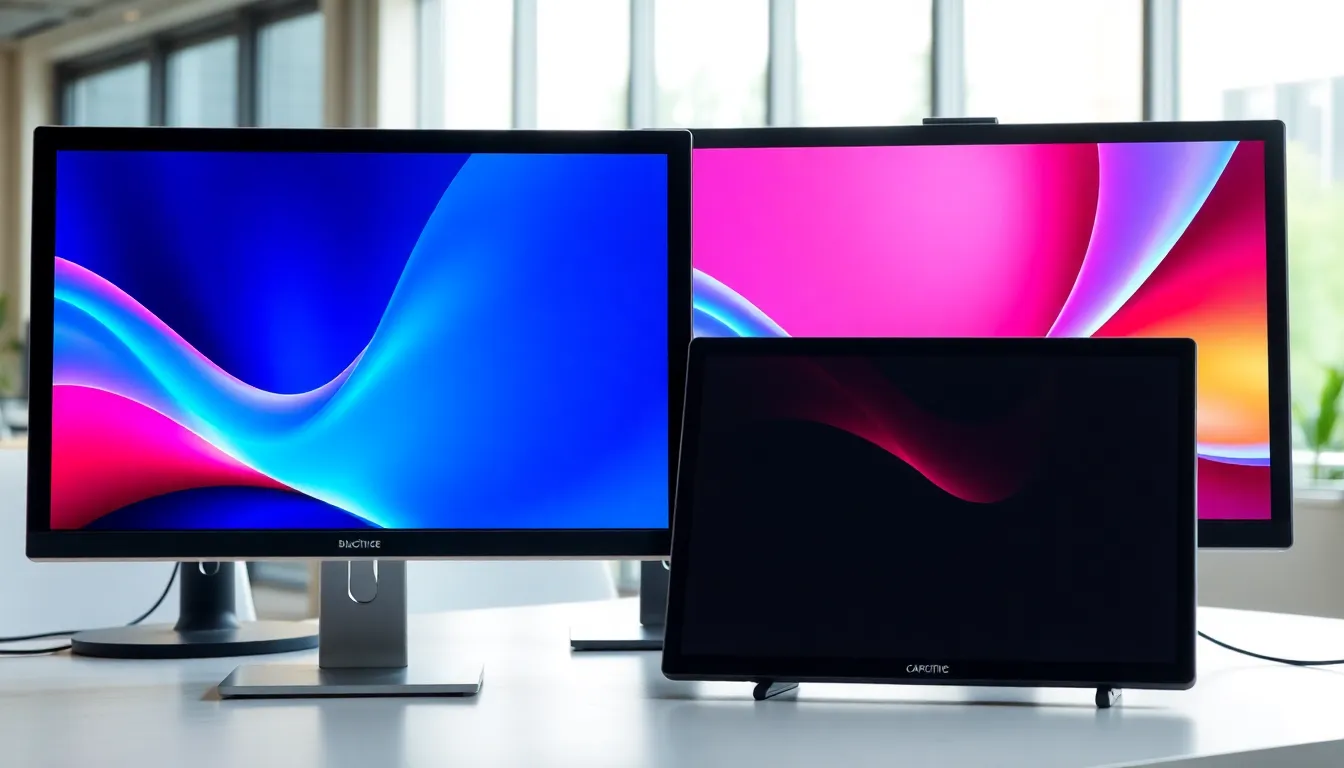In a world where finger taps have replaced keyboard clacks, touchscreen monitors are stealing the spotlight. Imagine swiping through your favorite apps or zooming in on that cat video with just a flick of your finger. Touchscreen monitors aren’t just a fancy gadget; they’re a game-changer that brings a new level of interactivity to daily tasks.
Table of Contents
ToggleOverview Of Touchscreen Monitors
Touchscreen monitors integrate display technology with direct user interaction through touch. Various types of touchscreen technologies exist, including resistive, capacitive, and optical systems. Capacitive touchscreens dominate the market due to their responsiveness and ability to recognize multiple simultaneous touches.
Applications for touchscreen monitors are widespread across industries. Retail environments utilize them for interactive kiosks, enhancing customer engagement. In healthcare, they facilitate quick access to patient data, improving workflow efficiency. Educational institutions adopt touchscreen monitors to create interactive learning experiences, fostering collaboration among students.
User experience consistently improves with touchscreen monitors. Intuitive interfaces simplify navigation, reducing the learning curve for new users. Gesture controls like pinch-to-zoom and swipe enhance interaction, making tasks more efficient than traditional input methods. Customization options allow businesses to tailor interfaces for specific needs.
Touchscreen monitors also offer various sizes and resolutions. Users can select from small devices for personal use to large displays suitable for presentations. High-definition screens provide clearer visuals, contributing to better overall user satisfaction.
Energy efficiency is another benefit of contemporary touchscreen monitors. Many models consume less power compared to traditional monitors, aligning with sustainable practices. As technology advances, these devices continue to evolve, incorporating features such as integrated webcams and built-in speakers.
The growth in touchscreen monitor usage reflects the changing dynamics in how people interact with technology. Adoption rates indicate a significant shift toward devices that prioritize user engagement. As touchscreen technology improves, it likely becomes a standard in both personal and professional settings.
Types Of Touchscreen Monitors

Touchscreen monitors come in several types, each designed to meet specific user needs and applications. Understanding these types aids in selecting the right device for various environments.
Capacitive Touchscreen Monitors
Capacitive touchscreen monitors use conductive materials to detect touch. They respond quickly to finger gestures, making interaction seamless. Multiple touch points can be recognized simultaneously, allowing for complex gestures like pinch-to-zoom. Users often prefer these monitors for their clarity and sensitivity. Retail environments frequently use capacitive screens for point-of-sale systems due to their responsiveness and durability.
Resistive Touchscreen Monitors
Resistive touchscreen monitors rely on pressure to register input. Composed of multiple layers, these screens detect touch when pressure from a finger or stylus causes the layers to contact each other. They tend to perform well in outdoor settings where gloves or styluses are used. Users appreciate them for their affordability and reliability. Healthcare environments often implement resistive screens for their robustness in clinical applications.
Optical Touchscreen Monitors
Optical touchscreen monitors function through infrared light or cameras, detecting touch based on disruptions to the light field. This technology allows for enhanced durability, as they lack a physical surface that can wear out. Users can interact with these monitors using various tools, such as fingers, pens, or even gloves. Versatile applications include kiosks and interactive displays in museums. The clarity and visibility of optical monitors make them suitable for both indoor and outdoor use.
Key Features To Consider
When choosing a touchscreen monitor, several key features play a crucial role in ensuring a satisfactory user experience.
Screen Size
Screen size directly impacts user interaction and visibility. Touchscreen monitors typically range from 10 inches to over 32 inches. Smaller sizes work well in confined spaces, like point-of-sale kiosks, while larger screens are ideal for presentations or collaborative work environments. Selecting an appropriate screen size enhances usability and comfort during extended use. Monitors with larger displays often support multitasking, allowing users to view multiple applications side by side.
Resolution
Resolution significantly affects image clarity and detail. Higher resolutions, such as 4K or Full HD, provide sharper visuals, making text and images pop. Viewing content like videos or graphics benefits from a higher pixel density as it enhances the overall experience. Users who frequently engage in graphic design or data visualization will appreciate monitors with superior resolutions. Additionally, reduced eye strain occurs with clearer screens, ensuring prolonged comfort during use.
Response Time
Response time is essential for seamless touch feedback. Monitors with rapid response times, often measured in milliseconds, provide quick and accurate touch recognition. A lower response time is critical in gaming or real-time applications, where delays can hinder performance. Users notice a marked improvement in interactions when devices respond promptly to touch commands. Quick response times enhance overall functionality, making for a more enjoyable experience across various applications.
Advantages Of Touchscreen Monitors
Touchscreen monitors offer numerous advantages that enhance user interaction and productivity. One significant benefit is the intuitive nature of touch controls. Users engage directly with the content, leading to quicker navigation and reduced learning curves.
Increased engagement occurs when users can perform tasks simply by tapping or swiping. The immediacy of touch interaction fosters a more dynamic experience, particularly in environments like retail and education. This interaction allows for a more interactive learning experience among students and staff.
Versatility stands out among the advantages of touchscreen monitors. They suit various industries with different applications, ranging from healthcare to customer service. Environments that require quick information access benefit greatly from these devices.
Energy efficiency represents another key benefit. Modern touchscreen monitors consume less power compared to traditional displays, aligning with sustainability goals. This reduced energy consumption contributes to long-term cost savings for businesses.
Responsive technology enhances the user experience. Capacitive touchscreen monitors, for example, support multi-touch gestures and provide quick feedback. Users appreciate the swift interaction, particularly in fast-paced settings.
Compact designs appeal to users seeking space-saving solutions. Touchscreen monitors come in a range of sizes, making them suitable for both small workspaces and large presentations. Their adaptability ensures that users can find a monitor that fits their specific needs.
Collaboration improves significantly with touchscreen monitors in shared environments. Multiple users can interact with the display simultaneously, facilitating teamwork and brainstorming sessions. This shared engagement leads to enhanced productivity and creativity.
Durability often characterizes touchscreen monitors, particularly those designed for industrial use. Models with rugged features withstand heavy use and resist damage from spills or impacts. This durability ensures a longer lifespan, making them a worthwhile investment.
Overall, touchscreen monitors provide intuitive, efficient, and engaging solutions across many sectors. Their diverse applications and user-friendly nature position them as essential tools in modern workplaces.
Disadvantages Of Touchscreen Monitors
Touchscreen monitors come with specific drawbacks that users should consider. One significant issue is glare, which can diminish visibility in bright environments. Dust and fingerprints accumulate quickly on screens, impacting clarity and requiring regular cleaning.
Touch recognition accuracy suffers when users do not make precise touches, leading to frustration and potential errors. Lag in response time occasionally occurs, particularly with higher resolution monitors when performing complex gestures.
Compatibility problems arise with certain applications that don’t support touch features, limiting functionality in specialized tasks. User fatigue may develop during extended use due to continuous reaching and touching, especially with larger screens.
Touchscreen monitors typically cost more than traditional monitors, where pricing reflects advanced technology and materials involved. Maintenance also tends to be more expensive, particularly for devices requiring specialized repairs.
Durability is another concern, as touch-sensitive screens might not withstand drops and impacts as well as traditional displays, increasing the potential for damage. Users may find themselves replacing touchscreen monitors more frequently in demanding environments.
While touchscreen monitors offer user-friendly features, it’s crucial to weigh these disadvantages against their benefits. Understanding these factors can guide users in selecting the most suitable monitor for their needs.
Touchscreen monitors have undeniably reshaped how users interact with technology. Their intuitive design and diverse applications make them invaluable across various sectors. As advancements continue to emerge, these devices are set to become even more integrated into daily life.
While touchscreen monitors offer numerous benefits like enhanced engagement and energy efficiency, potential drawbacks such as glare and maintenance costs must be considered. Users should carefully evaluate their specific needs to select the most appropriate touchscreen monitor.
Ultimately, the evolution of touchscreen technology signals a shift towards more interactive and user-friendly environments, making it an essential tool for both personal and professional use.



